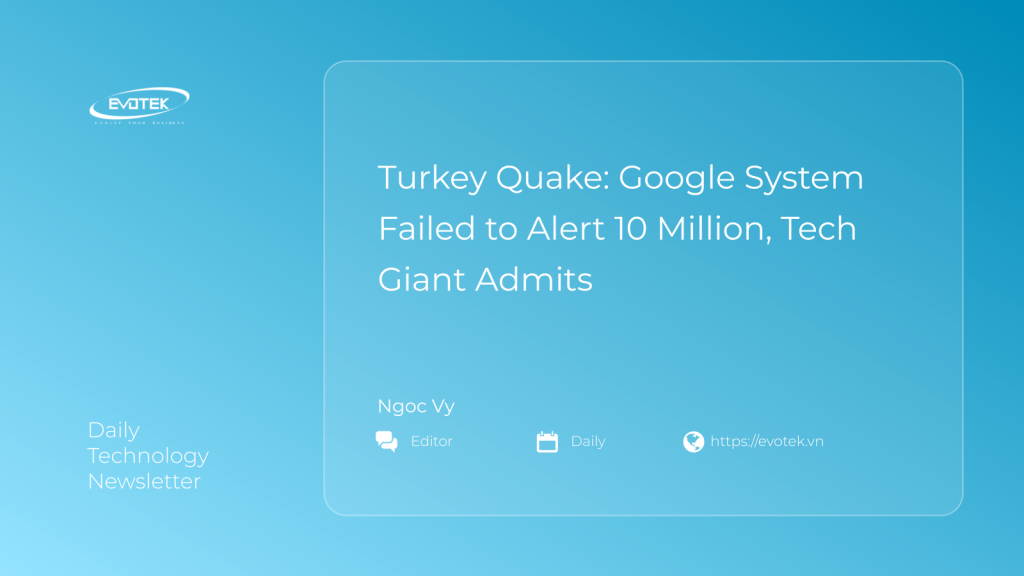Google has confirmed a significant malfunction in its Android Earthquake Alerts (AEA) system, revealing it failed to provide accurate warnings to millions during the catastrophic Turkey earthquakes in 2023.
An estimated 10 million individuals residing within 98 miles (158 km) of the earthquake’s epicenter were eligible to receive Google’s most critical “Take Action” alert, which offers up to 35 seconds of crucial warning time to seek safety. However, this paramount alert largely failed to reach them.
Shockingly, for the initial 7.8 magnitude tremor, merely 469 “Take Action” warnings were successfully dispatched. Furthermore, approximately half a million people received a lower-tier “Be Aware” warning, intended for “light shaking” and designed not to interrupt users as prominently, Google informed the BBC.
This admission stands in stark contrast to Google’s previous assertion in 2023, when the tech giant stated its system had “performed well” following an internal investigation.
Described by Google as a “global safety net,” the AEA system operates in nearly 100 countries, frequently serving regions that lack alternative national earthquake warning infrastructure. Managed solely by the Silicon Valley firm, the Android Earthquake Alerts (AEA) system functions independently of individual national governments. Its functionality relies on Android devices, which constitute over 70% of mobile phones in Turkey, making its reach potentially vast.
The devastating earthquakes that struck south-east Turkey on February 6, 2023, claimed over 55,000 lives and injured more than 100,000 people. The first quake, hitting at 04:17 AM local time, caught many residents asleep, trapping them in collapsing buildings.
Despite being fully operational on the day of the tremors, Google’s early warning system significantly underestimated the true strength of the earthquakes.
A Google spokesperson commented, stating, “We continue to improve the system based on what we learn in each earthquake.”
How the Android Earthquake Alerts System Works
The AEA system leverages the vast network of Android-powered mobile phones. These devices, equipped with accelerometers, can detect the subtle initial shaking of an earthquake. Given that seismic waves travel through the earth at a relatively slower speed than digital signals, a warning can theoretically be sent out to users ahead of the stronger shaking.
Google’s most severe alert, termed “Take Action,” triggers a loud, persistent alarm on a user’s phone, overriding “Do Not Disturb” settings and prominently displaying a full-screen notification. This critical alert is designed to be deployed when significant shaking capable of threatening human life is detected.
Conversely, the “Be Aware” warning is a less intrusive notification, informing users of potential lighter shaking without overriding “Do Not Disturb” settings.
The “Take Action” alert’s ability to override sleep modes was particularly crucial in Turkey, given the catastrophic intensity of the shaking and the 04:17 AM timing of the first quake, when most residents were asleep. Only such a prominent alarm could have roused them.
Investigation and Algorithm Changes
In the months following the disaster, the BBC actively sought out individuals who had received the “Take Action” warning, initially hoping to demonstrate the system’s efficacy. However, despite extensive efforts and interviews with residents across numerous affected towns and cities over several months, the BBC was unable to locate a single individual who had received the crucial “Take Action” notification prior to the earthquake. These concerning findings were subsequently published later that year.
In a detailed publication in the Science journal, Google researchers outlined the system’s shortcomings, attributing the failure to “limitations to the detection algorithms.” Specifically, for the first major earthquake, the AEA system dramatically underestimated its magnitude, calculating it between 4.5 and 4.9 on the moment magnitude scale (MMS), whereas its actual magnitude was a devastating 7.8.
The system similarly underestimated a second significant earthquake that struck later the same day. For this event, 8,158 “Take Action” alerts were sent, alongside just under four million “Be Aware” alerts.
Following the catastrophic events, Google’s researchers modified the algorithm and conducted a re-simulation of the initial earthquake. With the updated algorithm, the simulation revealed that the system would have generated 10 million “Take Action” alerts for individuals at highest risk and an additional 67 million “Be Aware” alerts for those further from the epicenter.
Addressing the challenge, Google told the BBC that “Every earthquake early warning system grapples with the same challenge – tuning algorithms for large magnitude events.”
Implications and Expert Concerns
The delay in receiving this critical information has drawn criticism. Elizabeth Reddy, an assistant professor at the Colorado School of Mines, expressed concern that it took over two years for these details to emerge. She stated, “I’m really frustrated that it took so long.” Reddy underscored the gravity of the situation, remarking, “We’re not talking about a little event – people died – and we didn’t see a performance of this warning in the way we would like.”
Google maintains that its system is intended to be supplementary and not a substitute for established national warning infrastructures. Nonetheless, some scientists voice apprehension that countries might be placing excessive reliance on technology that hasn’t undergone comprehensive testing.
Harold Tobin, director of the Pacific Northwest Seismic Network, emphasized to the BBC the paramount importance of transparency: “I think being very transparent about how well it works is absolutely critical.” Tobin raised a pertinent question: “Would some places make the calculation that Google’s doing it, so we don’t have to?”
Google researchers assert that post-event analysis has led to significant improvements in the system, which has now issued alerts in 98 countries. The BBC has sought information from Google regarding the AEA’s performance during the recent 2025 earthquake in Myanmar but awaits a response.

 日本語
日本語 한국어
한국어 Tiếng Việt
Tiếng Việt 简体中文
简体中文